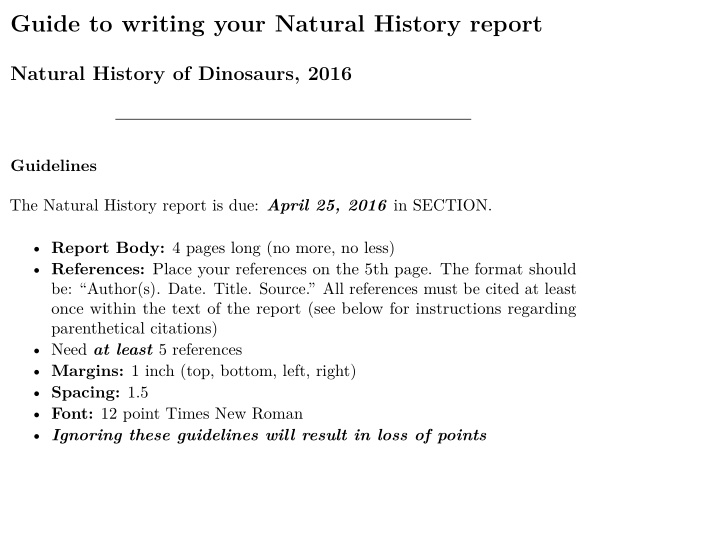



Guide to writing your Natural History report Natural History of Dinosaurs, 2016 Guidelines The Natural History report is due: April 25, 2016 in SECTION. • Report Body: 4 pages long (no more, no less) • References: Place your references on the 5th page. The format should be: “Author(s). Date. Title. Source.” All references must be cited at least once within the text of the report (see below for instructions regarding parenthetical citations) • Need at least 5 references • Margins: 1 inch (top, bottom, left, right) • Spacing: 1.5 • Font: 12 point Times New Roman • Ignoring these guidelines will result in loss of points
Fastovsky ch. 12 + maybe ch. 11? (only if we cover these chapters in class)
~ Ceratosaurs ~ Spinosaurs Basal Theropods
~ Therizinosaurs ~ Carnosaurs ~ Tyrannosaurs Intermediate Theropods
~ Troodontids ~ Dromaeosaurids Derived Theropods
Oviraptor Therazinosaurs Avialae Tyrannosaurs Spinosaurs Troodontids Dromaeosaurids Ceratosaurs Carnosaurs Ornithomimosaurs Derived Intermediate Basal Theropods: Simplified
Carnosaurs Big nostrils and elaborate sinuses Large bodied (> 5 m long) Big head Allosaurus
Carnosaurs Giganotosaurus; Late Cretaceous South America Skull was 6.3 ft long 16 meters (52 ft) long May have preyed on large Sauropods
Possibly a pack hunter. 16% larger brain than similar-sized carnivores *WINNING* Giganotosaurus; Late Cretaceous South America 16 meters (52 ft) long
Carnosaurs Charcarodontosaurus; Mid Cretaceous Africa 15 meters (50 ft) long
Carcharodont-osaurus ‘jagged tooth’-reptile
~ Therizinosaurs ~ Carnosaurs ~ Tyrannosaurs Coelurosauria
OOPS Coelophysis vs Compsognathus
Arctometatarsal ankle = faster runners? yes yes no
Coelurosaurs: An Equine Analogue
Tyrannosaurs Guanlong: basal Tyrannosaur Laelaps Large bodies, short arms T. rex : last and largest Tyrannosaur
Horse-sized primitive tyrannosaur Timurlengia euotica from the middle Cretaceous (ca. 90 million to 92 million years ago) of Uzbekistan.
Ornithomimosaurs Small, lightly built skulls with tiny orbits No upper teeth, few lower teeth Long arms
Struthiomimus; Late Cretaceous N. America 4.3 meters (14 ft) long
~ Therizinosaurs ~ Carnosaurs ~ Tyrannosaurs Coelurosauria
Maniraptorans: Evolution of the semi-lunate carpal ~ wrist bone that increased hand dexterity
Oviraptor
Therazinosaurs Plant-eating teeth? Backward pointing hips 3 ft. long claws Nothronychus Erlikosaurus
Therazinosaurs Ground Sloths of the Mesozoic?
~ Troodontids ~ Dromaeosaurids Derived Theropods
Troodontids Troodon Sinvenator
Troodontids Troodon Sinvenator
Birds Reptiles Troodon Velociraptor
Dromaeosaurids Velociraptor Deinonychus
“ Boreonykus , a new species of dinosaur about the size of a dog and possessing a lethal claw. The remains of the Boreonykus were discovered at the Pipestone Creek bonebed — a huge gravesite of the plant-eating dinosaur Pachyrhinosaurus that dates back 73 million years.”
Dromaeosaurids Utahraptor
Theropod Teeth Dromaeosaurids Recurved Larger serration-length to tooth-length ratio slash-and-tear Tyrannosaurids Conical; bulky Smaller serration-length to tooth-length ratio CRUSH-AND-DESTROY Dromaeosaurus Tyrannosaurus
Independent loss of teeth among Theropod dinosaurs Ornithomimids: Omnivorous? Oviraptors: Egg eaters? Nope. Small vertebrates/invertebrates Mollusk shells? Eggs, Seeds, Fruits Large seeds?
Theropod Skulls Robust
Theropod Skulls Gracile
Recommend
More recommend